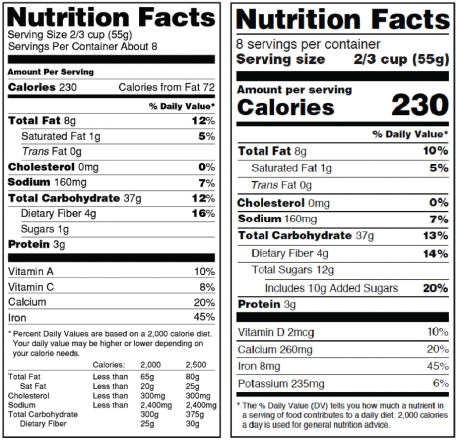How to Read the New Food Label
By Mary Spiegelberg and Lindsay Howard, MS, CSCS
We see them every day, but how many of us actually understand them? First thing’s first, the best way to determine if a product is nutritious is to ignore all of the claims on the front of the package that say things like “all natural” or “sugar free.” Flip that sucker around and focus your eyes on the Nutrition Facts label.
NOTE: the current FDA laws have changed, and a NEW nutrition fact label has recently been created.
OLD Label VS. NEW Label

Serving Size:
Let’s start at the top. The serving size is defined as quantity (for example: 2 cookies), amounts (2/3 cup, 4 tbsp.), or as weight (3 oz.). One serving size is what all values on your label will be referencing. Directly under that, the label will tell you how many serving sizes are in the package or product.
BE AWARE: The serving size is NOT the amount that is recommended for your diet. This is simply the measurement that the Nutrition Facts are based on.
In the example above, we see there are two 1 oz. servings in our cashews. If we were to consume the whole package, we would need to double the amount of calories, total fat content, carbohydrates, proteins and so forth.
Calories, Macronutrients & Percentages:
The percentages on the right refer to the percent recommended intake based on a diet of 2000 calories a day. Thus, the percentage of fat, carbohydrate and protein is not appropriate for each individual. It does help consumers understand the proportion of macronutrients (carbs, protein, fat) in the food, and can serve as a reference point. so may not be completely accurate to your individual diet. It is more appropriate to reference the grams of each macronutrient. For example, diabetics must keep an accurate log of their carbohydrate intake. Referencing the grams of carbs per serving can help one to determine proper portions.
Wondering how grams are converted to calories? There are 9 calories in each gram of fat, 4 calories in each gram of carbohydrate, and 4 calories in each gram of protein. Overwhelmed yet? It’s a lot to take in! This is why we like to encourage clients to eat in “handfuls,” until they are satisfied, thereby becoming in tune with their bodies. If we reach for nourishing foods the rest will typically take care of itself.
Fiber:
The Institute of Medicine recommends a daily fiber intake of 25 grams per day for females and 35 grams per day for males. Unfortunately, the average American diet falls short and consumes roughly 15 grams per day. Foods naturally-rich in fiber (without added fiber) are whole grains such as whole- or sprouted grain bread, brown rice, quinoa, whole-grain pasta (brown rice or quinoa works too!), and whole-grain crackers. And don’t forget your foods without labels! Fruits and veggies are full of fiber!
Sugar:
One of the best new features of the new food label is the “added sugars” line. This will differentiate naturally occurring sugars from sugars that have been added to the product. The current American Heart Association Guidelines recommend no more than 150 calories from added sugar for men, and 100 calories for women per day. This equates to approximately 25 grams and 37.5 grams respectively.
Ingredient List:
Here’s a fun fact – ingredients are list ed in order of what is most abundant to what is least abundant in a food product. This is helpful when determining the contents of a food product. For example, when selecting a quality yogurt, identify a brand with yogurt and real fruit (apricots, strawberries, etc.). Sugar or high fructose corn syrup should not be the first ingredients.
Vitamins and Minerals:
Vitamins and minerals, also known as the micronutrients, concludes our nutritional label, again with their percentages being based off a 2000 calorie diet. Reaching the “daily value” of micronutrients is essential to reach peak bodily function. The new label will include the following select vitamins and minerals: Vitamin D, calcium, iron and potassium. While all micronutrients are important, these have been identified as nutrients recently lacking in the average American diet. By listing these nutrients on the label, consumers are passively encouraged to consume foods rich in these micronutrients.
Remember, many of the healthiest foods come without a nutrition label. Things like fruits, vegetables, grass-fed meats and wild-caught salmon. While nutrition labels have their purpose, we will leave you with our favorite mantra, “Don’t count calories, make calories count!”






